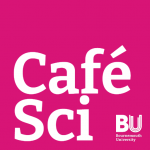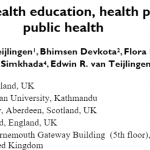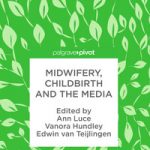Dr Sue Thomas shares her experience of presenting at a BU Café Scientifique event on 6 July 2021.
For my talk at Café Scientifique I took a fresh look at the topic of my 2017 book “Nature and Wellbeing in the Digital Age: How to feel better without logging off”, which has new relevance in the age of digital wellbeing during COVID-19. This continued the theme of my previous book, “Technobiophilia: Nature and Cyberspace”, which looked at the prevalence online of nature-derived metaphors and imagery, and which I discussed at Café Sci in 2013.
My talk topic – Technobiophilia
Intuitively we all know that Nature is good for us. Research has backed that up, showing that contact with nature can support emotional wellbeing and better concentration, as well as reduce stress and lower heart rate and blood pressure. Sometimes even simple psychological connectedness to nature can produce the same effects.
Biophilia is a hypothesized hidden programme which runs in the background of our lives. The term was first coined by Erich Fromm but became more popular when the eminent biologist EO Wilson described it as “the innate attraction to life and lifelike processes”. Wilson believes that biophilia may have the ability to lie dormant for periods of time until something triggers it into action again.
The notion of biophilia led to my own definition of ‘technobiophilia’ as “the innate attraction to life and lifelike processes as they appear in technology”. Technobiophilia connects our lives in nature with our lives in the digital, and this process has been very evident during the Covid-19 Lockdowns. Here are some examples:
- In October 2020, the Metro newspaper declared that “Nature documentaries are ‘perfect lockdown viewing and make people happier’ in an article about the TV programme “Seven Worlds, One Planet” which highlighted the story of the last two northern white rhinoceros left alive on the planet.
- On Instagram, thousands of RSPB #breakfastbirdwatch watchers shared their photos. Sussex_sara posted “Is anyone else feeling in a state of suspended animation these days? 😕 Living alone, the only tangible sense I have of days passing are the changes in nature as our lives are put on hold.”
- Country Life magazine, perhaps not the most techie of periodicals, listed the best live animal webcams to get you through lockdown. Their Top 3 were: Little penguins, Phillip Island Nature Parks, Australia; Folly Farm, Pembrokeshire (sheep, goats, newborn lambs) and Edinburgh Zoo (Panda cam, Penguin Cam, Koala Cam and Lion Cam)
- The BBC launched a collaboration to bring virtual soundscapes of music and nature directly to audiences with Radio 3, 6 Music, and BBC Sounds, and also embarked on The Virtual Nature Experiment with The University of Exeter, a ground-breaking study exploring how virtual experiences of nature might impact wellbeing.
- Nintendo relaunched its old online game “Animal Crossing” and it was soon dubbed ‘the game of the pandemic’. Slate Magazine said “Animal Crossers new and old found comfort in exerting control over their islands’ virtual terrain as the world outside grew more and more chaotic” and the MIT Technology Review reported that “Gentle, comforting games like Nintendo’s latest hit are perfect escapist entertainment, but they’re also helping us to connect in these strange times.”
This last observation was born out by a study conducted before the pandemic and published in 2020, which reported a significant increase of feelings of connectedness to the community after watching digital nature. Interestingly, they also found that tended nature scenes elicited more social aspirations than wild nature scenes.
In 2020, Natural England surveyed the changing relationship with nature during lockdown. It reported that 41% of people said that visiting natural spaces had become even more important to them than before. Also in 2020, in a study conducted before the pandemic, the University of Exeter found that the best way of delivering virtual nature for improving mood was computer-generated virtual reality, which proved more effective than high definition TV or 360° video.
During the lockdown pause, Nature was busy regenerating. As early as April 2020, carbon dioxide and nitrogen dioxide fell by up to 40%. Air traffic fell 50%. UK road traffic fell 70%. And during that year, wildlife came closer – wild goats wandered the empty streets of Llandudno, coyotes walked across the Golden Gate Bridge, there were deer in Washington DC, and wild boar in Spain and Italy. Everyone heard more bird song. By April 2021, marine noise pollution had decreased so much that the seas had become measurably quieter.
So, what has lockdown taught us about digital nature and wellbeing? It seems that we have learned that we can connect with nature in many different ways, both physically and digitally. We have been reminded that we can live more of our lives outdoors, and that nature can help connect our local communities.
But individual nature connection is not enough. Covid has taught (some of us) to better connect with nature, but has that process sedated us? Distracted us? Separated us even more from what else is happening? This year, floods and fires around the world have reminded us that there are other disasters too, most of them a result of the global warming.
While we in the First World are busy self-soothing with nature, many millions of people have no access to vaccines. In January 2021, Dr Tedros Adhanom Ghebreyesus WHO Director-General, warned “The world is on the brink of a catastrophic moral failure – and the price of this failure will be paid with lives and livelihoods in the world’s poorest countries.”
Of course, this moral failure can be seen in the climate emergency too. In his 2020 film ‘A Life on Our Planet’ David Attenborough delivered his Witness Statement and told the story of ‘our greatest mistake’. The film begins and ends in Chernobyl which, although still devoid of humans, has seen the return of many thriving animals and plants. This allows Attenborough to make his final message one of hope. ‘We have’, he says, ‘the opportunity to become a species in balance with nature’.
When my book ‘Technobiophilia: Nature and Cyberspace’ was published in 2013, some thought the idea of using technology to connect with nature was contradictory, even harmful. But the last 18 months of the pandemic have shown the benefits of nature in the digital age, for some of us at least. But there is much more work to do. Perhaps digital nature can play a part in helping humanity to finally, to quote Attenborough, “become a species in balance with nature” – if there is time.
My Café Scientifique experience
I enjoyed my second Café Scientifique session. It went very well and was followed by a lot of positive feedback and a lively exchange of ideas, which brought the July lecture to a successful conclusion, slightly over the scheduled two hours.
The audience asked some excellent questions and we were pleasantly able to deepen our exchanges. It was interesting to hear from those providing opportunities for engaging with digital nature, especially Radio Lento https://radiolento.podbean.com/ who produce entrancing virtual nature tours in the form of weekly sound postcards from beautiful places. Find them on Twitter @RadioLento where they regularly share some wonderful sounds. There was a lively exchange of views about the relative values of visual, audio, VR and analogue nature experiences, especially when created from the same sources.
It was a great experience with people from all over the world, including old friends. My talk was recorded and is available to watch on the Café Sci YouTube channel. I hope that it inspires you to think and act on the relationship between nature, digital nature and our well-being.
Dr Sue Thomas’s blog is here: www.suethomas.net Her book ‘Nature and Wellbeing in the Digital Age’ can be purchased here: https://amzn.to/3mlTTVe
If you have any questions about Café Scientifique, or would like to get involved, please get in touch publicengagement@bournemouth.ac.uk
 Café Sci – Tuesday 6 July: What has lockdown taught us about digital nature and wellbeing?
Café Sci – Tuesday 6 July: What has lockdown taught us about digital nature and wellbeing?










 Bournemouth University psychologists publish new book
Bournemouth University psychologists publish new book Connecting Research with Practice: FoodMAPP Secondment in Austria and France
Connecting Research with Practice: FoodMAPP Secondment in Austria and France Health promotion paper read 8,000 times
Health promotion paper read 8,000 times The Beautiful Work Challenge: On Birth
The Beautiful Work Challenge: On Birth Free event on Solutions to Inequalities in Dementia Diagnosis and Care
Free event on Solutions to Inequalities in Dementia Diagnosis and Care MSCA Postdoctoral Fellowships 2025 Call
MSCA Postdoctoral Fellowships 2025 Call ERC Advanced Grant 2025 Webinar
ERC Advanced Grant 2025 Webinar Horizon Europe Work Programme 2025 Published
Horizon Europe Work Programme 2025 Published Horizon Europe 2025 Work Programme pre-Published
Horizon Europe 2025 Work Programme pre-Published Update on UKRO services
Update on UKRO services European research project exploring use of ‘virtual twins’ to better manage metabolic associated fatty liver disease
European research project exploring use of ‘virtual twins’ to better manage metabolic associated fatty liver disease